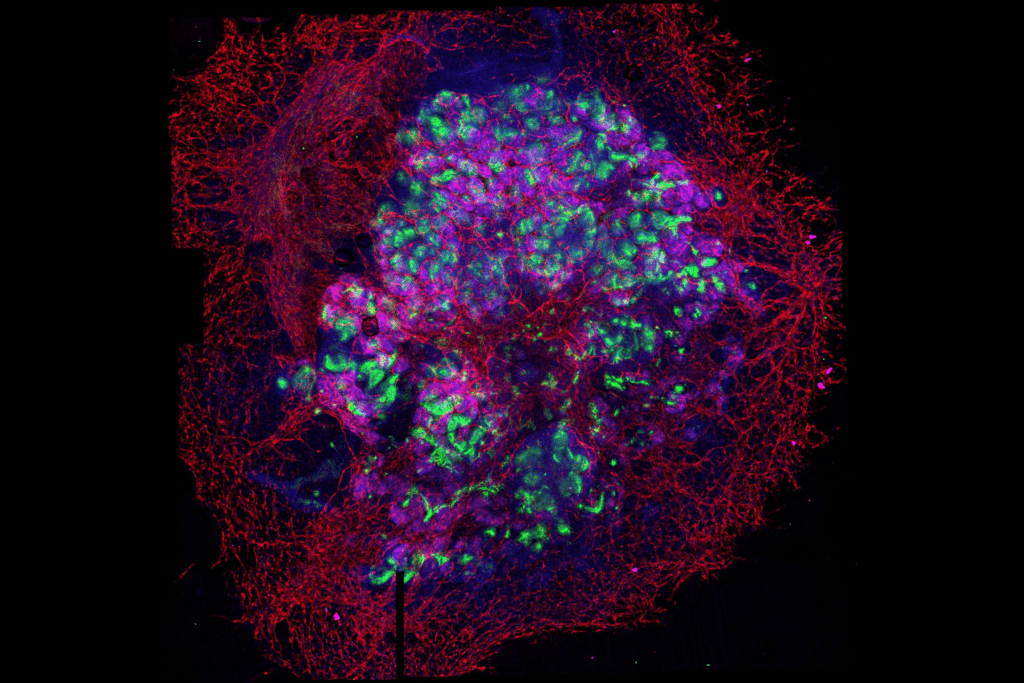These are asembloids, micrometric organoids formed by the union of kidney organoids with vascular organoids in 3D. These small culture systems are useful for disease modelling and drug screening. The study, led by IBEC, describes an approach that has not been tried before.

A study led by the Institute for Bioengineering of Catalonia (IBEC) describes a new approach to producing mini-kidneys in the laboratory that mimic a complex vasculature, similar in some characteristics to those of the human kidneys. These “asembloids” are created by combining 3D kidney organoids with endothelial organoids.
Organoids are three-dimensional structures grown in vitro that mimic organ function and are a promising tool for disease modelling and drug screening. However, these small organs often lack nervous, immune, or vascular systems due to their complexity.
When these two types of organoids are together, they start a process of interaction in just three hours. The result of this process is truly spectacular.
Núria Montserrat Pulido
Reproducing the complex vascular system of the kidney, a highly perfused tissue, in the laboratory has been a challenge for scientists for more than a decade. Now, a paper published in the prestigious scientific journal Advanced Materials, describes an approach that has never been tried before:
“We assembled kidney organoids with vascular organoids. To carry out this process successfully, it is essential to identify the ideal time to join them, taking into account the developmental stage of each organoid,” explains Núria Montserrat Pulido, ICREA Research Professor, Principal Investigator at IBEC and leader of the study. “When these two types of organoids are together, they start a process of interaction in just three hours. The result of this process is truly spectacular,” she says.
These findings not only provide valuable insights into the development of renal organoids, but also lay the groundwork for the development of new methods to vascularise these organoids. This could have applications in organoid transplantation in clinical settings and in the study of vascular dysfunction in human disease.
“We need to have this vascular system in our organoids if we want to model systemic pathologies that affect the kidney through the bloodstream, such as an autoimmune disease or diabetes, for example. We also believe that the approach we have used in this study could also be applied to other organoid models,” says Elena Garreta Bahima, researcher in the Montserrat group at IBEC and first author of the study.
The next step, says Montserrat, will be to introduce these vascularized organoids on a microfluidic chip to be able to carry out even more specialized studies in order to mimic conditions that occur in complex diseases as well as to allow vascular connection with other organoids, such as cardiac organoids, work that is currently being carried out in the laboratory at IBEC.
Printing with cells
In previous studies, the team had seen that the kidney organoids they created contained a vascular component: endothelial cells, the cells that eventually form blood vessels. Using porcine or human kidney tissue, they created a biocompatible hydrogel that could be used as a 3D printing ink.
We need to have this vascular system in our organoids if we want to model systemic pathologies that affect the kidney through the bloodstream, such as an autoimmune disease or diabetes, for example.
Elena Garreta Bahima
On this basis, they decided to simplify the system to make it more accessible and economical. Among all the proteins that make up the hydrogel, they chose collagen I, one of the most abundant proteins in the extracellular matrix of kidney tissue, and generated a biocompatible gel with which to validate their experimental results.
This work represents a significant milestone in the field of emerging and advanced therapies, one of IBEC’s key research areas. These therapies are innovative medical treatments that use cutting-edge technologies to address complex diseases and conditions.
The study has also brought together researchers from other centres that are part of the National Platform of Biomodels and Biobanks of the Carlos III Institute of Health (PISCIII-BB), highlighting the importance of network collaboration in defining biomedical solutions based on bioengineering. This platform, coordinated by Núria Montserrat, Deputy Director of Clinical Translation Initiatives at IBEC, provides high-level scientific and technological services by integrating and coordinating the activities of all its units in response to the needs of the National Health System, in addition to managing more than 500,000 biological samples and related clinical data.
In addition to IBEC, the Centre for Applied Medical Research (CIMA) of the University of Navarre, the Institute for Biomedical Research of A Coruña (INIBIC), the Leartiker Technology Centre (Basque Country), the Hospital Clínic de Barcelona and the Gregorio Marañón General University Hospital (Madrid) participated in the study.
Referenced Article:
Elena Garreta, Daniel Moya-Rull, Andrés Marco, Gaia Amato, Asier Ullate-Agote, Carolina Tarantino, Maria Gallo, David Esporrín-Ubieto, Alberto Centeno, Amaia Vilas-Zornoza, Rafael Mestre, María Kalil, Izar Gorroñogoitia, Ane Miren Zaldua, Samuel Sánchez, Laura Izquierdo Reyes, María Eugenia Fernández-Santos, Felipe Prosper, and Nuria Montserrat. Natural Hydrogels Support Kidney Organoid Generation and Promote In Vitro Angiogenesis. Advanced Materials (2024). DOI: https://doi.org/10.1002/adma.202400306





